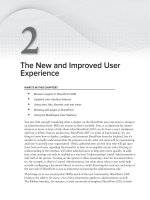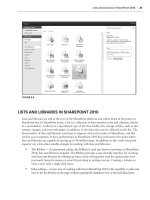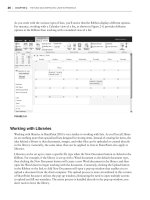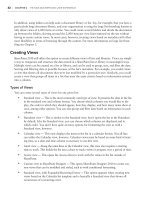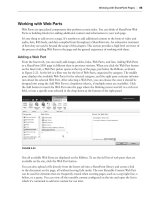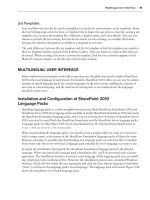Thủ thuật Sharepoint 2010 part 10 ppsx
Bạn đang xem bản rút gọn của tài liệu. Xem và tải ngay bản đầy đủ của tài liệu tại đây (239.04 KB, 6 trang )
Architecture and
Capacity Planning
WHAT’S IN THIS CHAPTER?
SharePoint products and licenses
Critical non-SharePoint servers
Hardware specifi cations
Tools for controlling your deployment
SharePoint 2010 has greatly expanded its functionality from previous versions. New features
include the following:
Offi ce web applications, where you can display and edit Offi ce documents in the
browser
The Fluent UI, aka the Ribbon
An enhanced social experience, including tagging and notes
More fl exibility regarding how web applications consume services through service
applications
A full-scale business intelligence offering through tools such as Performance Point
Services, Reporting Services, and Excel Services
Those and about a million (not an exact number) other new features in SharePoint 2010 are
reasons why people are so excited about the product. Of course, all of that new functionality
means that users will deploy SharePoint for more tasks than ever before — and that increased
traffi c leads to more demands from a hardware perspective. As a result, administrators can antici-
pate a strong increase in the number and size of servers in their farms. In short, it is expected that
3
60
CHAPTER 3 architectUre aNd caPacity PlaNNiNg
the same user from SharePoint 2007 will come to a SharePoint 2010 farm with more requests per
second (RPS).
To help you scale, the Shared Services Provider (SSP) from 2007 has gone the way of the Dodo bird.
In its place, Microsoft has introduced a new services architecture that is infinitely more configu-
rable, which also means it is infinitely more complicated.
This chapter begins with a primer on the different versions of SharePoint 2010 you can expect to see,
including a brief overview of SharePoint in the cloud. Then, because a SharePoint DVD isn’t good for
much more than a coaster until you have the supporting servers on which to install it, you will learn
all of the software requirements you are expected to bring to the table.
Armed with the necessary software knowledge, the discussion will turn to hardware, including the
amount of metal you will need, ways you might consider scaling up versus out, and where virtual-
ization might come into play. Finally, the chapter describes some of the clever new tools available
that will help you keep SharePoint in check in your environment.
While this might not be as exciting as a blockbuster Hollywood movie, it will turn you into what
every good summer blockbuster needs: a superhero. Therefore, read carefully and make sure you
picked up your cape from the dry cleaners.
WHAT’S IN A NAME?
As it turns out, in the Microsoft world there is quite a bit to a name. If you have any past SharePoint
experience, you probably know the names of the previous products, Windows SharePoint Service 3.0 (WSS)
and Microsoft Office SharePoint Server 2007 (MOSS). And given the success of these two products, it
is pretty reasonable to assume their names would continue. This time around, the names are SharePoint
Foundation and SharePoint Server 2010.
The key change here to note is the removal of Windows and Office from the product names. This
speaks volumes about the success of SharePoint. The product is now considered to stand on its own
and is no longer part of the Windows or Office groups. Being decoupled from these two groups will
open the door for SharePoint to be more agile going forward and will be nothing but good news for
everyone in the SharePoint fan club.
SharePoint Foundation
SharePoint Foundation will continue the legacy that WSS has established over the years and should
keep that friendly price point that makes it so attractive. The name SharePoint Foundation is a perfect
match for what the program brings to the table. As an administrator, it is easy to think of the prod-
uct only in terms of the features you readily see in the browser — things like creating team sites and
collaborating on content within lists and libraries, or features such as blogs, wikis, RSS feeds, alerts,
and easy browser-based customizations.
Yet underneath all of that great functionality is where some of the true power of SharePoint is
hidden. Here, the foundation provides developers with a great platform to build from. Out of the
box, it handles storage, web presentation, authorization, user management, and has an interface
into the Windows Workflow Foundation — and because all of this functionality is easily accessible
What’s in a Name?
61
through the object model, APIs, and web services, it can greatly accelerate a developer’s job. Rather
than build all of those infrastructure pieces for every web-based product, developers can leverage
SharePoint Foundation and concentrate on just building the solution.
SharePoint Server 2010
SharePoint Server 2010 is considered the premium product. It offers additional collaboration capa-
bilities and extends the scenarios beyond Foundation. Through its tools, it enables better aggrega-
tion and displaying of content, which makes building things such as portals much simpler. It also
introduces additional web content management tools that enable developers to use Server as a plat-
form for building Internet-facing websites.
This is all done by extending the capabilities introduced by SharePoint Foundation. Any time you
install SharePoint Server, the Foundation product is installed automatically as well. Keep this in mind
as you manage your environments, making sure you keep current on both Foundation and Server
issues, as you really have both products. When you are doing tasks like applying service packs or
adding third-party applications, this knowledge might just change how you go about things.
Standard and Enterprise
As in the past, SharePoint Server 2010 is available primarily in two fl avors, either Standard or
Enterprise. Standard introduces core functionality like social, search, and advanced web and enter-
prise content management. Enterprise focuses primarily on adding functionality through new service
applications, introducing business intelligence, line of business integration, reporting, and some Offi ce
client services such as Visio.
This is all provided through a client access license (CAL) model. You only need to run one setup
program, which puts all of the binaries on the server; and based on the license key you enter, either
the Standard features will be available or both the Standard and Enterprise features. You are required
to have an appropriate CAL for each user accessing SharePoint Server 2010.
SharePoint licensing is a notorious black hole and cannot be covered completely
in this book, as each scenario is unique and should be treated as such. The infor-
mation provided here is guidance to help you understand the concepts in order
to make more informed decisions and to understand the platform as a whole, but
it should not be considered the fi nal word on licensing. Please consult your license
reseller or Microsoft Licensing for specifi cs before making any purchase.
For Internet Sites
Because of the tremendous popularity of SharePoint on the intranet, a new trend has been for com-
panies to also host their Internet site on SharePoint. From a business perspective this can greatly
reduce the cost through the reuse of a familiar tool. By not having two separate platforms to create
“websites,” it is no longer necessary to maintain two separate yet similar skill sets. This also reduces
licensing and hardware costs because some systems, such as development environments, can be used
62
CHAPTER 3 architectUre aNd caPacity PlaNNiNg
for both internal and external projects. This is usually not possible if you have two separate prod-
ucts in place. For most companies, reducing training, licensing, development, and administrative
costs sounds like just the answer bean counters are looking for.
While MOSS had an Internet license, it was an all-or-nothing model. It included all of the MOSS
Enterprise features, which typically meant a hefty price tag. However, many companies only wanted
the core web content management (WCM) functionality, not those extra features and their associated
cost. Microsoft heard these pleas loudly and clearly, and addressed the issue in SharePoint Server 2010.
There is now a SharePoint Server 2010 for Internet Sites Standard license as well as an Enterprise
license. You will often hear this license referred to by its acronym, FIS, regardless of what version
they truly mean. The goal of introducing the Standard license is to offer smaller sites the capability
to deploy on Server for their web presence. It is then throttled to permit only a set amount of traf-
fic, and will not have the Enterprise features available. However, it should be just what the doctor
ordered when it comes to getting a simple WWW site up and off the ground.
One very important thing to understand about FIS is where it is applicable. Remember that everyone
who will access the SharePoint Server site needs a CAL. When building an intranet portal, it is easy
to count how many employees you have and to purchase a CAL for each one of them; but when you
stand up and make it available to the world, now how many CALs do
you need? There are roughly 1.8 billion people on the Internet, and potentially every one of them
can come to your website. That’s a lot of CALs to buy. Luckily, this is where FIS comes into play. It
allows unlimited non-employee access to your SharePoint Server. The reason why non-employee is
emphasized is because this license does not cover any of your employees and there has been a lot of
confusion over the license in the past. The proper FIS license can help you control the cost of your
SharePoint Server deployment, but great care should be taken to use it properly.
Search Server 2010
For most users, one of the major downsides of SharePoint Foundation is its lack of a powerful search
feature. Foundation can provide search results of the SharePoint content from within a given site
collection, but that is all. It cannot pull search results from multiple site collections, and cannot add
external content sources such as file shares or Exchange public folders.
In addition, many users have become very reliant on the use of a search engine in their daily lives. Bing
and Google are typical first stops for most users as they explore the Internet for everything from buy-
ing a new car to figuring out why their in-laws give them a headache. For most of these users, it is only
logical that they should be able to discover information at work in the same manner. SharePoint Server
2010 can provide this full-scale enterprise search presence, but not everyone can afford to deploy it.
Other users look to some type of appliance to index and search the intranet, but these devices can be
difficult to administer and even more cost prohibitive. Enter Search Server 2010 Express and Search
Server 2010.
Search Server 2010 Express (SSX) is a free product from Microsoft that essentially takes SharePoint
Foundation and adds to it the intranet searching capabilities. You gain the capability to add content
sources such as file shares, other SharePoint sites, websites, and Exchange public folders. You also
get the Search Center template and all of the associated Web Parts. To avoid stealing all of the thun-
der from Chapter 14, this simple feature list will have to suffice for now; but if any of that interests
What’s in a Name?
63
you, consider deploying SSX instead of Foundation, or if you have Foundation already deployed,
you can simply upgrade Foundation to SSX.
The only real shortcoming of SSX is that it cannot be configured to be high availability. While
Search Server 2010 can be configured to avoid any single point of failure, including the Search com-
ponents, SSX does not offer that capability. It can only be deployed to one server in the farm; there
is no infrastructure for deploying it on multiple servers to create redundancy. If you need a high-
availability solution, you need to move up to full Search Server. The only downside to the full version
is that it is a for-purchase product.
Fast Search Server 2010
In early 2008, Microsoft purchased Fast Search and Transfer. Fast was considered the “best in breed”
high-end search tool set. In the 2010 product line, it has been incorporated as an addition to the
SharePoint Server platform, adding lots of new functionality, including the following examples:
Visual search and best bets
Extreme scale, with a billion documents possible
Enhanced multiple language capabilities
Better handling of unstructured data through metadata extraction
Better handling of structured data such as numbers, dates, etc.
Adding all of this to SharePoint’s already very powerful search engine is a huge win. There will be
two different licenses for this feature: Fast Search Server 2010 for SharePoint will be used along
with the Server Enterprise CAL in intranet deployments, whereas Fast Search Server 2010 for
Internet Sites will be used in conjunction with FIS for public websites.
These two Fast products have been completely integrated into the SharePoint platform, providing an
easy to use management interface and Windows PowerShell cmdlets. From a development perspec-
tive, they are also plugged into the object model (OM) the same way normal SharePoint Server Search
is. Therefore, users don’t have to learn anything new in order to get results returned. Instead, they
make the same calls to the Search OM, and Fast returns information in place of the normal search
engine.
There is a third license worth mentioning even though it is outside the scope of this book — Fast Search
Server 2010 for Internet Business. This license will not be used in conjunction with SharePoint, but
instead for custom public websites. For example BestBuy.com uses Fast to help consumers find all
those gadgets and gizmos they love to buy. Unlike SharePoint, which is usable as is, this product is
more a set of tools that need to be assembled to provide an amazing search experience.
SharePoint Online
Another push for SharePoint from Microsoft will be SharePoint in the cloud, hosted by Microsoft. If
you are looking to deploy SharePoint using this model, then you can probably stop reading the book at
the end of this section because in SharePoint Online, the entire server infrastructure is hosted and main-
tained for you. This model removes the administrative overhead of SharePoint and lets the business
64
CHAPTER 3 architectUre aNd caPacity PlaNNiNg
focus just on using the power that is SharePoint. (While this might be great for the business, it does
eliminate the need for a SharePoint administrator, so many of us will consider this license option the
enemy.)
There are actually two models to consider with SharePoint Online: shared and dedicated. The shared
model provides you with a slice of a shared farm and enables you to use SharePoint out of the box.
Server-deployed code and customizations are not permitted. The dedicated model enables you to run
your own farm, and you are allowed to make approved customizations to the server. Any change must
be packaged in a solution package and validated by Microsoft before being deployed to the server. All
licenses are bought per user.
This offering has also been expanded from previous versions to add some new licensing options.
One of these is the concept of the “deskless worker.” These are users you can add at a lower price
point, and they have mostly read-only access to SharePoint. There are also models available that can
support hosting a partner collaboration site and public-facing Internet sites.
This chapter covers SharePoint Online because it is an additional available SKU
in this product cycle, but you have other notable options if you are looking at a
hosted scenario. Companies such as RackSpace.com and Fpweb.net offer hosted
SharePoint environments that you may fi nd a little more fl exible than SharePoint
Online. Of course, hosting internally is still the best option, but it is good to know
your enemies.
OTHER SERVERS
So you signed up to be a SharePoint administrator? Well, congratulations, you are also now respon-
sible for a whole host of software. Since SharePoint isn’t an operating system (yet!), you need to have
the right operating system in place in order to deploy SharePoint. Additionally, SharePoint stores
99% of the content and confi guration in a database, so SQL Server has to enter the conversation
sooner, rather than later. Also, most deployments want to take advantage of SharePoint’s ability
to send notifi cation e-mails, and some even take advantage of its ability to receive e-mails. Even
though you may not directly be responsible for these products, they will affect your livelihood. Users
don’t call to complain that SQL Server isn’t working; they call to complain that they cannot access
SharePoint. It is your job to determine that it is because SQL Server is not responding. This section
covers the ins and outs of these various pieces of this puzzle.
Windows Server
SharePoint is available only as 64-bit software, so by extension it can only be installed on servers
with 64 bits or more. And don’t bother looking, there is no 32-bit “test” version hiding out there.


